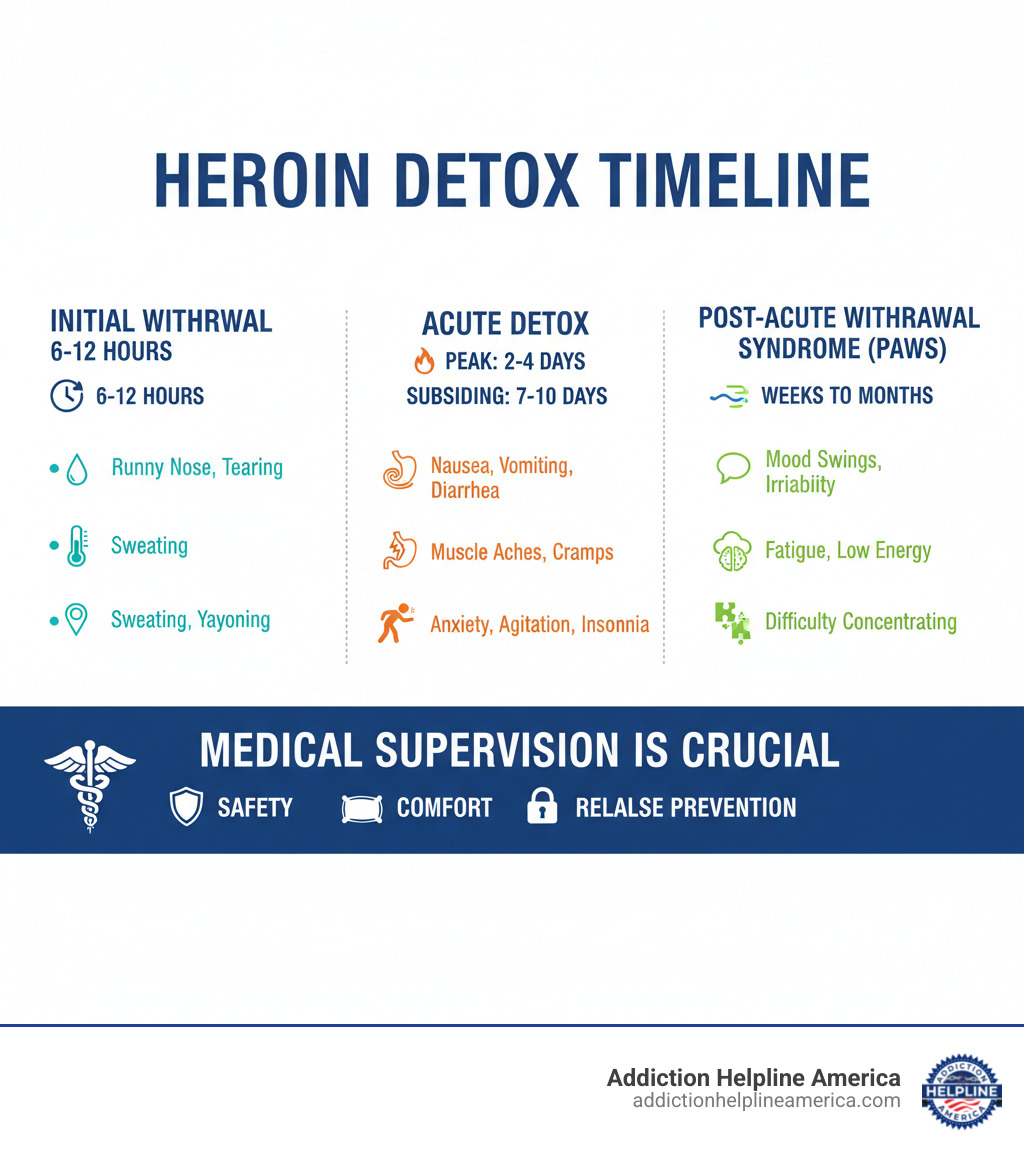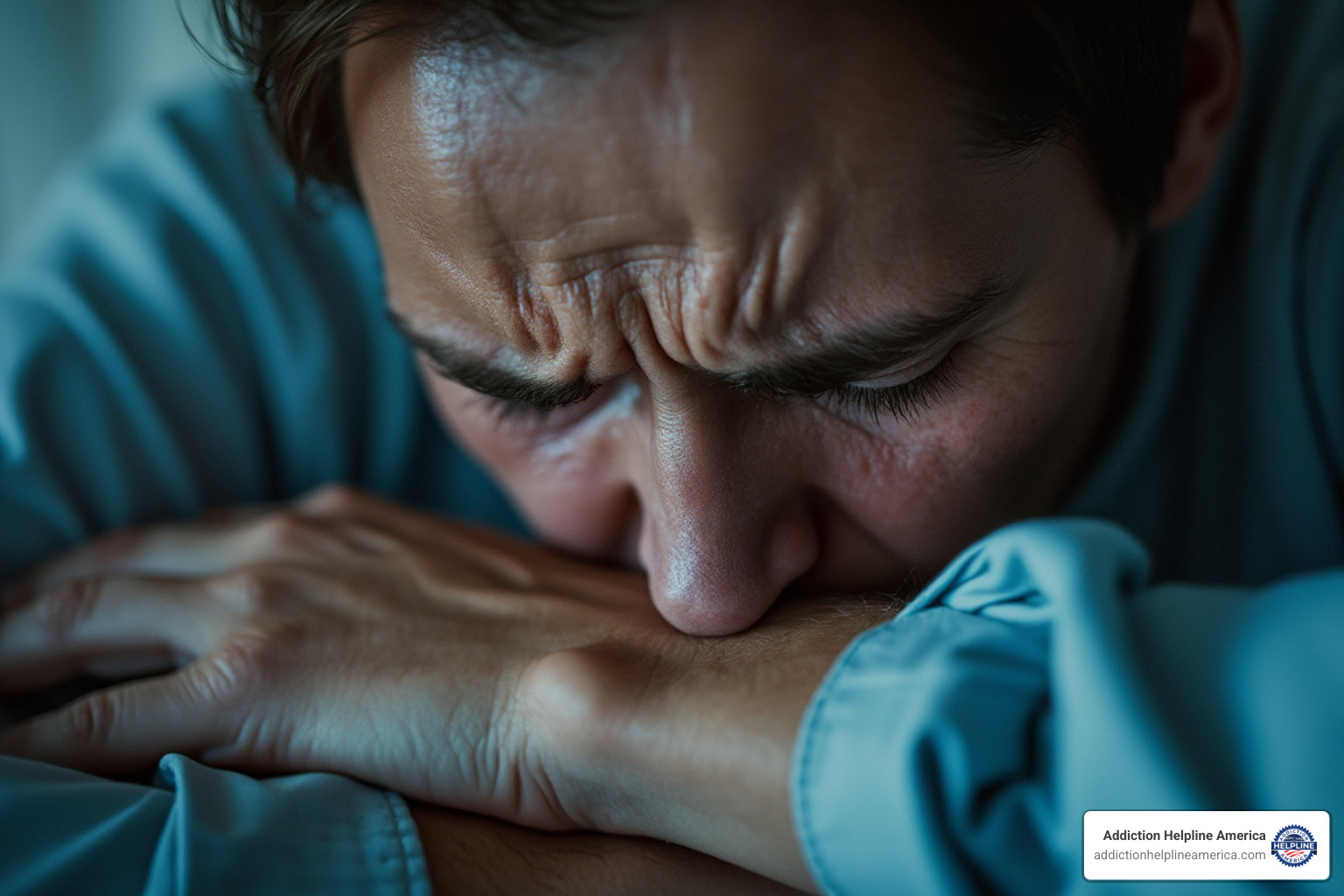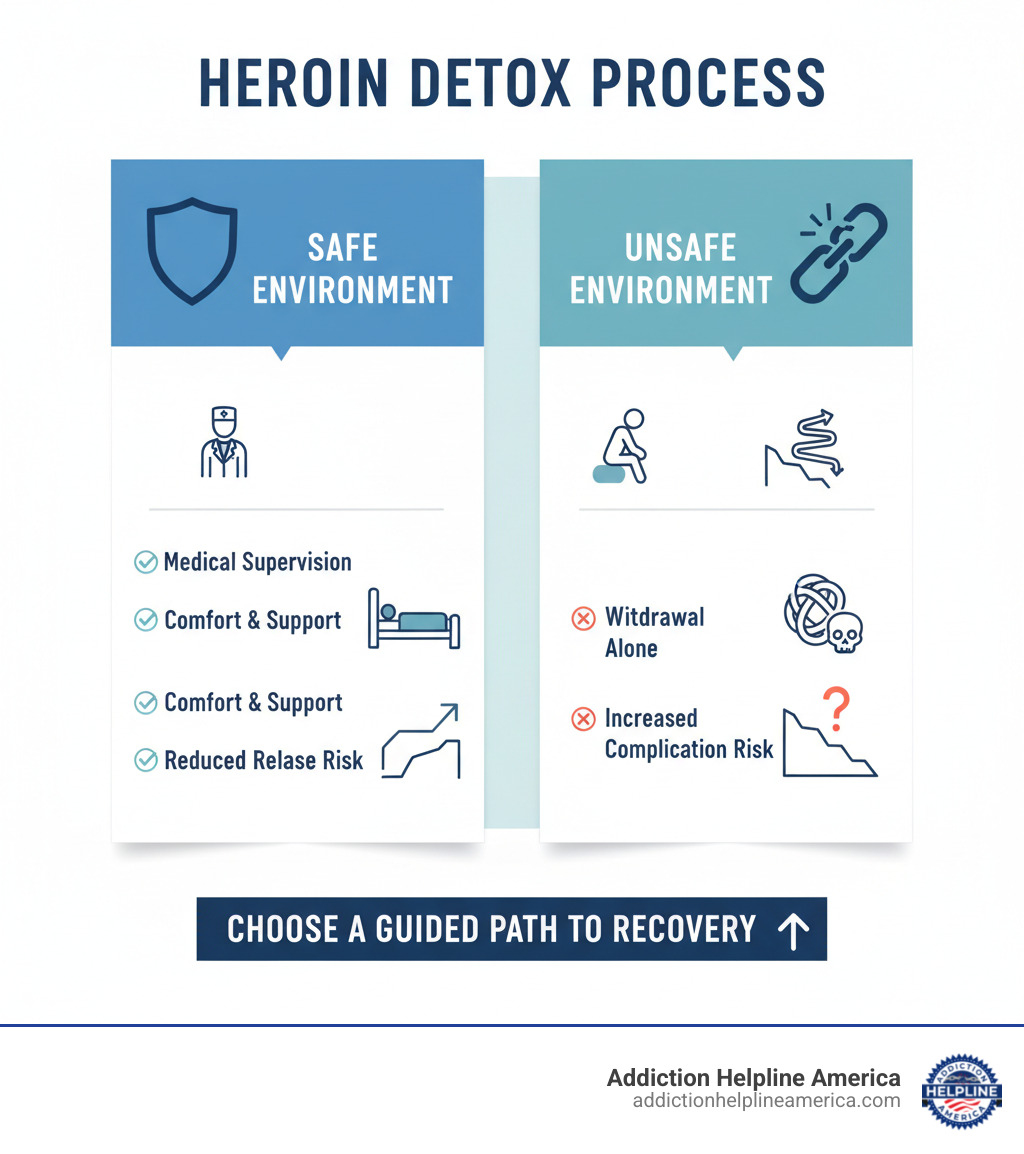Your Journey to a Healthier Life Starts Here
Free Insurance Verification
Verify Your Treatment Coverage
Verify Your Treatment Coverage
The Heroin Detox Process is the medically managed withdrawal from heroin. It clears the drug from your body while managing painful and potentially dangerous withdrawal symptoms. The process typically involves three stages: medical evaluation, stabilization with medication and support, and preparation for ongoing addiction treatment.
Timeline Overview:
Heroin withdrawal can be dangerous without medical supervision due to risks like dehydration, aspiration from vomiting, and a high chance of relapse. A significant danger occurs after detox when tolerance has dropped, as using the same previous amount of heroin can lead to a fatal overdose.
Professional help makes all the difference. Medically supervised detox uses medications and counseling to keep you safe and comfortable, setting you up for long-term recovery. Detox is the essential first step, not a complete treatment. It opens the door to recovery by addressing the physical dependence, but comprehensive treatment is needed to address the psychological aspects of addiction.
At Addiction Helpline America, we guide individuals and families through this process by connecting them with qualified providers. Our specialists are available 24/7 to answer questions, verify insurance, and help you find the right detox program for your unique situation.

When your body is physically dependent on heroin, stopping its use triggers withdrawal—a system shock that can feel overwhelming without support. The Heroin Detox Process follows a predictable timeline, though each person’s experience is unique. Symptoms typically start within 6 to 12 hours of the last dose, peak between days 2 and 4, and fade within 7 to 10 days. Factors like usage history, amount used, and overall health influence the withdrawal experience, which is why a personalized detox plan is crucial.

Take the first step towards a healthier life! Call now to connect with our compassionate team and start your recovery journey today. Your path to healing awaits!
Our recovery specialists are available 24/7 to provide support, and all calls are confidential and free. Reach out anytime – we’re here to help!

Early withdrawal often feels like a severe flu. Within hours of the last dose, your body begins sending distress signals. Common early symptoms include:
This is the most difficult phase, when symptoms reach their peak intensity and the risk of relapse is highest. The body is in crisis, leading to severe physical and psychological distress. Symptoms include:
This stage highlights why medical supervision during the Heroin Detox Process is critical for safety and successful completion.
After the acute phase (7-10 days), some individuals experience Post-Acute Withdrawal Syndrome (PAWS). These are less intense, primarily psychological and emotional symptoms that can last for weeks or months as the brain heals. Understanding What is Post-Acute Withdrawal Syndrome (PAWS)? can help you prepare for this extended healing phase.
Common PAWS symptoms include:
PAWS demonstrates why detox is only the beginning. Ongoing support is necessary to manage these symptoms and build a foundation for lasting recovery.
The Heroin Detox Process is a structured medical journey to guide you safely from active addiction toward recovery. It begins with a comprehensive medical evaluation to create a personalized treatment plan based on your health and drug use history. This is followed by stabilization, where a medical team provides 24/7 monitoring and support to manage acute withdrawal symptoms. Nutritional support is also often included to help your body heal.
As physical symptoms subside, the focus shifts to fostering treatment readiness. Detox clears the drug from your body, but it doesn’t resolve the underlying causes of addiction. Continuing with comprehensive care is critical for long-term success, a principle supported by the National Institute on Drug Abuse. You can learn more about these Principles of Effective Treatment
Medication-Assisted Treatment (MAT) is a cornerstone of the modern Heroin Detox Process. It combines FDA-approved medications with therapy to manage withdrawal, reduce cravings, and prevent relapse. Key medications include:
Comfort medications are also used to treat specific symptoms like nausea, anxiety, and insomnia, making the process more tolerable. You can Learn more about Medications for Opioid Use Disorder.
While MAT handles the physical side, therapy addresses the psychological roots of addiction. An integrated approach is essential for building a foundation for sobriety.
Choosing the right setting is key to a safe detox. The main options are inpatient and outpatient care.
Inpatient Detox:
Outpatient Detox:
Our team at Addiction Helpline America can help you assess which level of care is right for your specific needs.
While detoxing at home might seem appealing for its privacy, attempting the Heroin Detox Process alone, or “cold turkey,” is extremely dangerous. Without medical supervision, you face the full force of withdrawal, leading to severe risks:
In a medically supervised setting, these risks are managed. Professionals monitor your vitals, provide fluids and medications to ease symptoms, and offer support in a safe, drug-free environment.

Critically, the period immediately following detox carries the highest risk of a fatal overdose. This is a physiological reality, not a scare tactic.
During active use, your body builds a high tolerance to heroin. Detox rapidly lowers this tolerance. If you relapse and use the same amount you did before detoxing, your body can no longer handle it. This is why using the same previous dose is dangerous—it can overwhelm your now-sensitive system, causing respiratory depression (breathing to stop) and death.
This dramatically reduced tolerance is why relapse prevention planning is a life-saving component of recovery. It’s also why having Naloxone, a medication that can reverse an opioid overdose, is so important. You can find Information on Naloxone for overdose prevention. At Addiction Helpline America, we help you connect with comprehensive treatment that prioritizes your long-term safety.
Completing the Heroin Detox Process is a monumental first step, but it’s not the finish line. Detox addresses physical dependence, but addiction’s psychological and behavioral roots require further healing. Continuing care after detox is so important because it provides the tools to build a sober life and significantly reduces the risk of relapse.
Recovery is about learning to cope with life’s challenges without heroin. This is what comprehensive addiction treatment provides—the support and guidance needed for long-term success.
After detox, rehabilitation focuses on the root causes of addiction. Several levels of care can support this phase:
At Addiction Helpline America, we can help you explore these options. Learn more about our treatment program options to find the right path forward.
Addiction is a chronic condition that often requires ongoing management. Building a strong support system is the backbone of sustained recovery.
At Addiction Helpline America, we understand that finding the right support can be overwhelming. We’re here 24/7 to connect you with the resources you need to build a lasting recovery.
Choosing the right Heroin Detox Process and treatment program is a critical decision. At Addiction Helpline America, we offer free, confidential guidance to connect you with the best program from our trusted network, cutting through the confusion.
When evaluating programs, look for key features that signal quality care. A reputable program will conduct a thorough individual needs assessment to create a personalized plan. If you struggle with co-occurring disorders like anxiety or depression, find a program offering integrated dual diagnosis treatment. Practical factors like location and cost also matter. We can help you verify your insurance coverage for free to understand your benefits.
Finally, consider the program philosophy and staff credentials. Find an approach that resonates with you, and ensure the team consists of qualified, licensed professionals. The Substance Abuse and Mental Health Services Administration (SAMHSA) is a good resource to begin your search, and you can Find help for substance abuse through their national helpline.
Asking the right questions helps you make an informed decision. Here are key questions to ask any potential provider:
Our advisors at Addiction Helpline America can help you ask these questions and find a high-quality program. We’re here 24/7 to guide you through this process and connect you with the right care for your unique situation.

Take the first step towards a healthier life! Call now to connect with our compassionate team and start your recovery journey today. Your path to healing awaits!
Our recovery specialists are available 24/7 to provide support, and all calls are confidential and free. Reach out anytime – we’re here to help!
The Heroin Detox Process is a courageous, life-saving decision that marks the beginning of your journey back to yourself. We know this step can feel overwhelming, but you don’t have to carry this burden alone. Hope is the lived reality of millions who have successfully steerd the path you’re about to begin.
Recovery is a journey of ups and downs. What matters most is taking that first step. Every person in long-term sobriety started exactly where you are now.
At Addiction Helpline America, we are the bridge between where you are and where you want to be. Our team takes the time to understand your unique situation, verify your insurance, and connect you with a fitting detox program—all at no cost and with complete confidentiality.
The most important step is the first one. Today can be that day. Your path to a healthier, freer life is waiting, and we’re here to help you find it. Reach out to us and let’s start this journey together.
Are you or a loved one struggling with addiction? Call today to speak to a treatment expert.
Calls to any general helpline will be answered or returned by one of the treatment providers listed, each of which is a paid advertiser:
Our helpline is available 24 hours a day, 7 days a week at no cost to you and with no obligation for you to enter into treatment. We are committed to providing support and guidance whenever you need it.
In some cases, Addiction Helpline America charges our verified partner a modest cost per call. This fee helps us cover the costs of building and maintaining our website, ensuring that we can continue to offer this valuable service to those in need.
Calls to the general helpline will be answered or returned by one of the listed treatment providers, all of whom are paid advertisers.
By using the helpline, you agree to the terms of use. We do not earn any commission or fee based on the treatment provider selected by the caller, and there is no obligation to pursue treatment.
This service is not affiliated with Alcoholics Anonymous World Services, Inc.